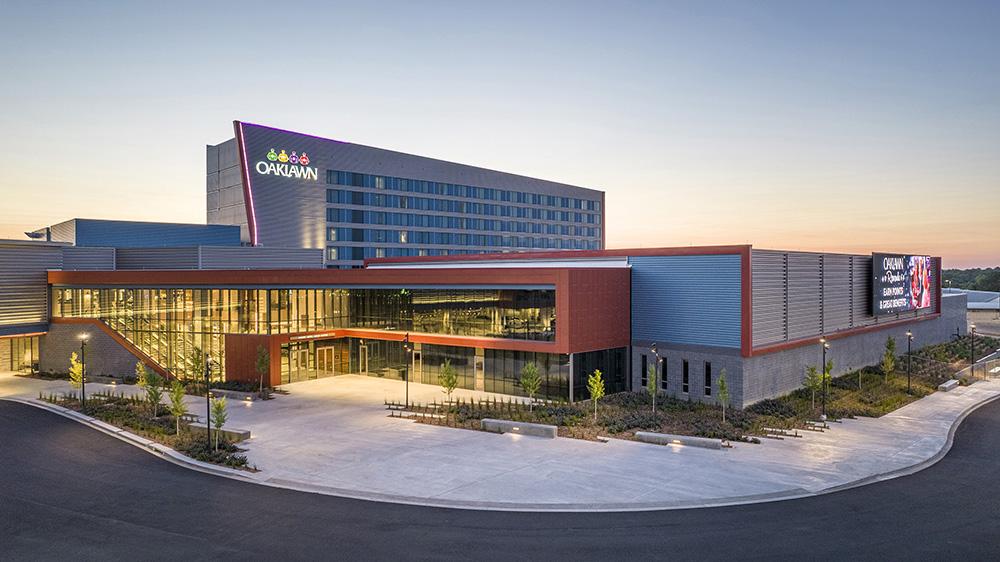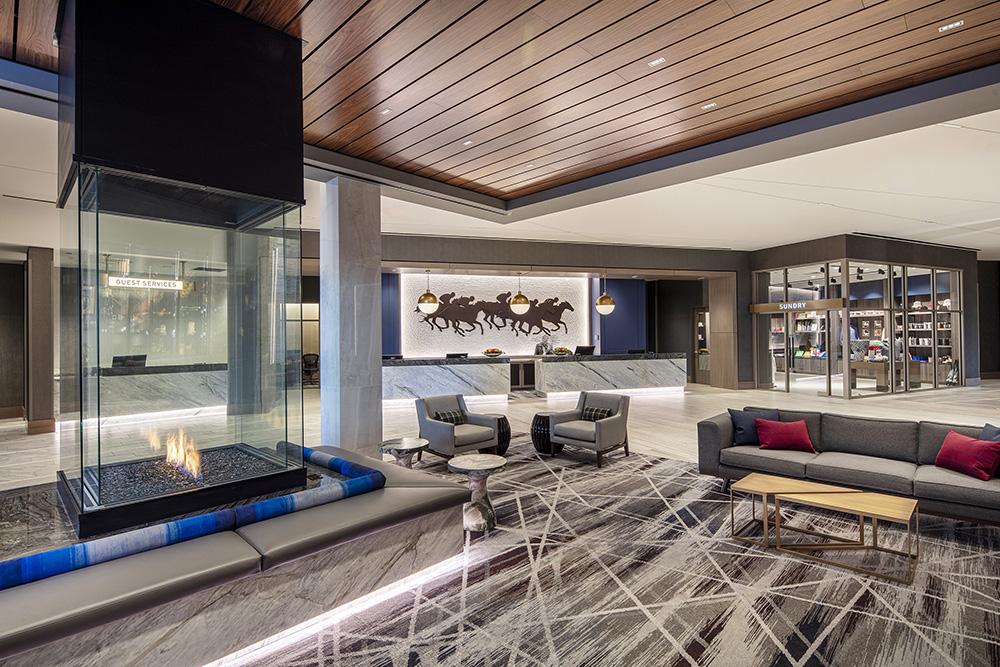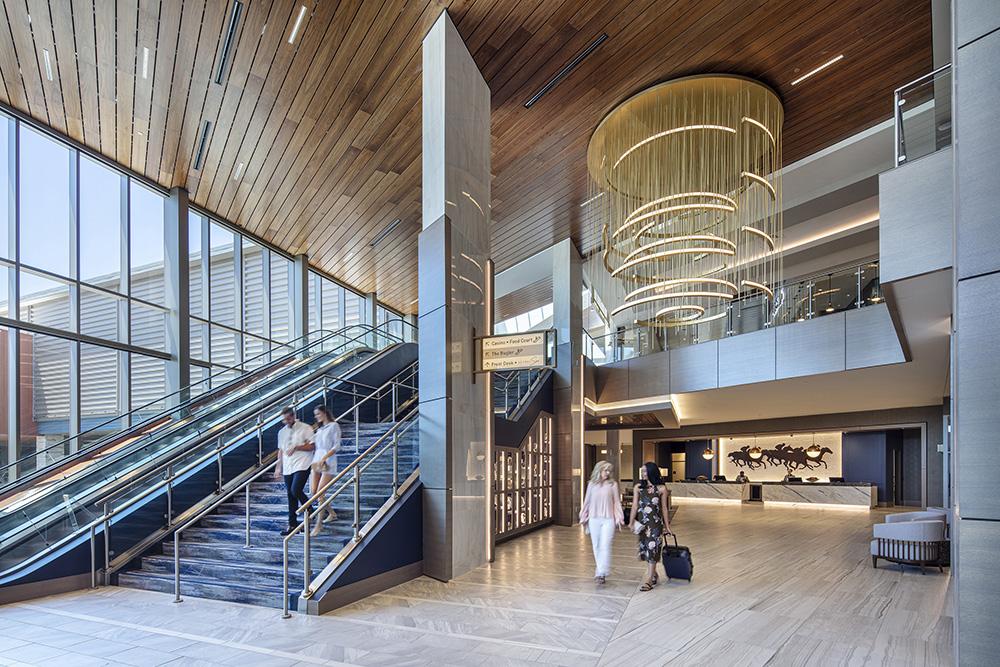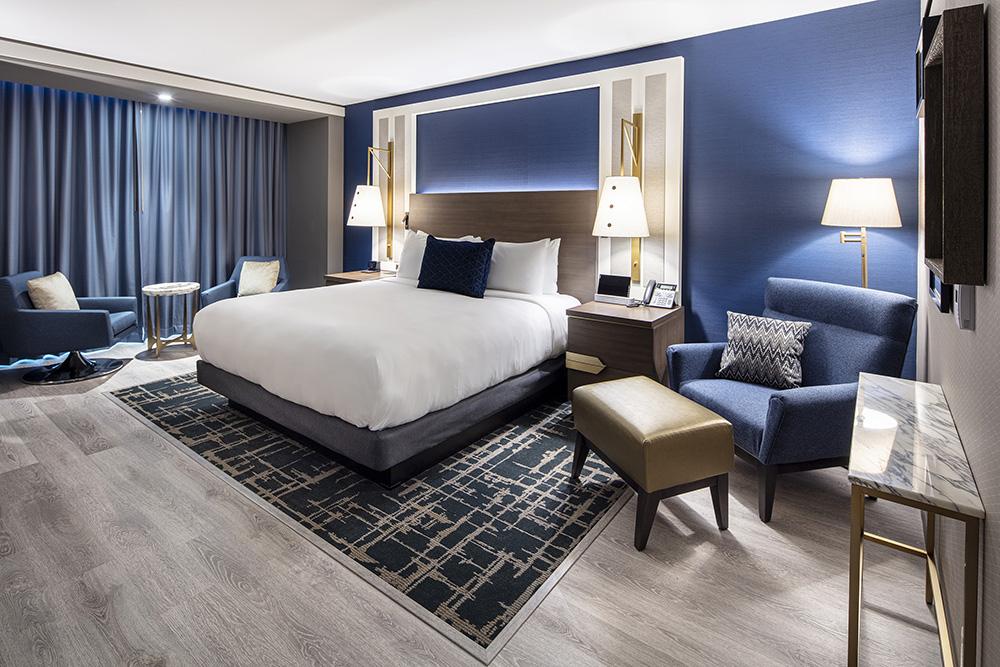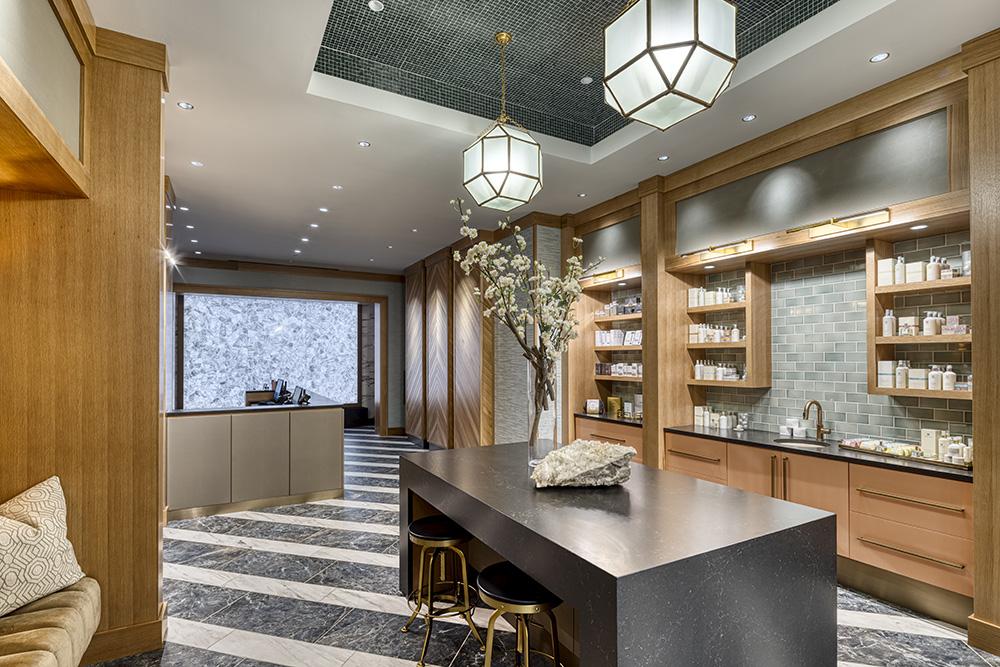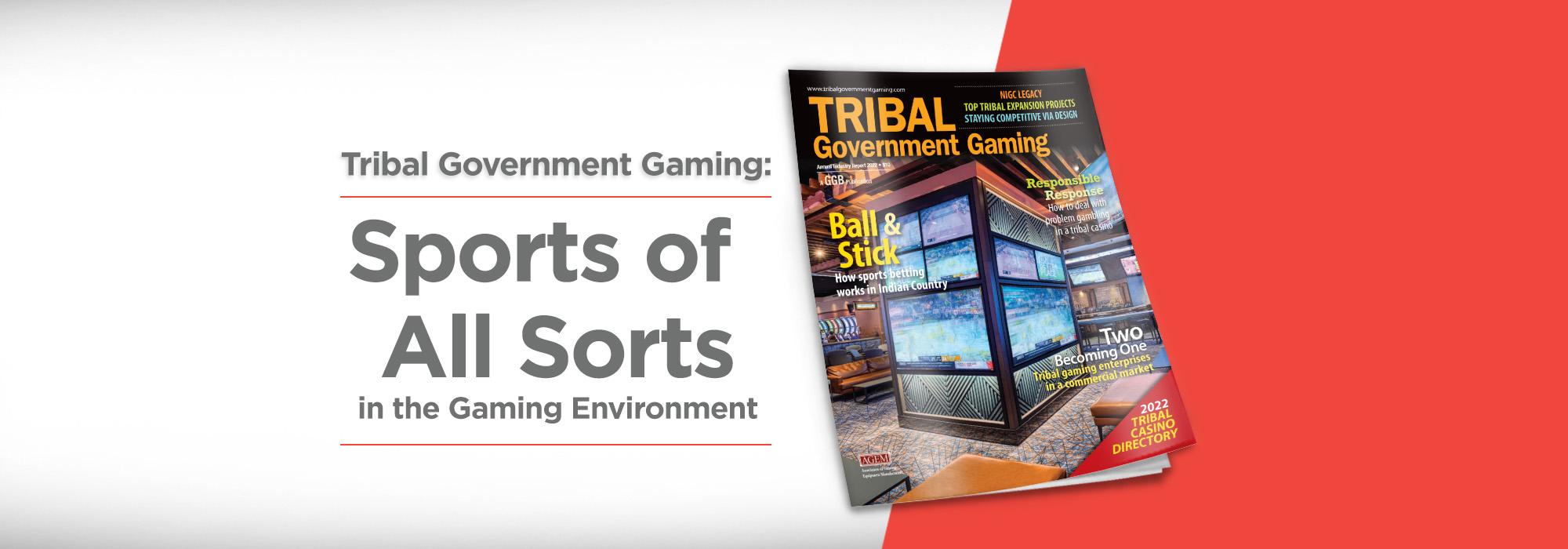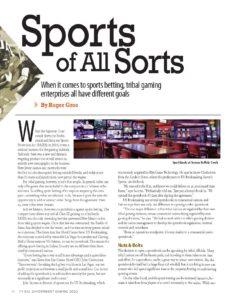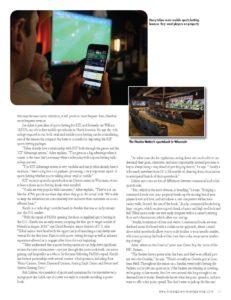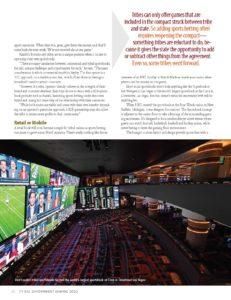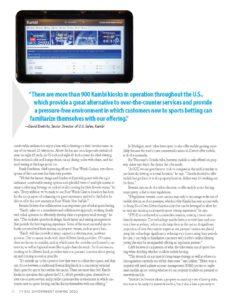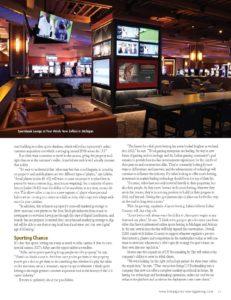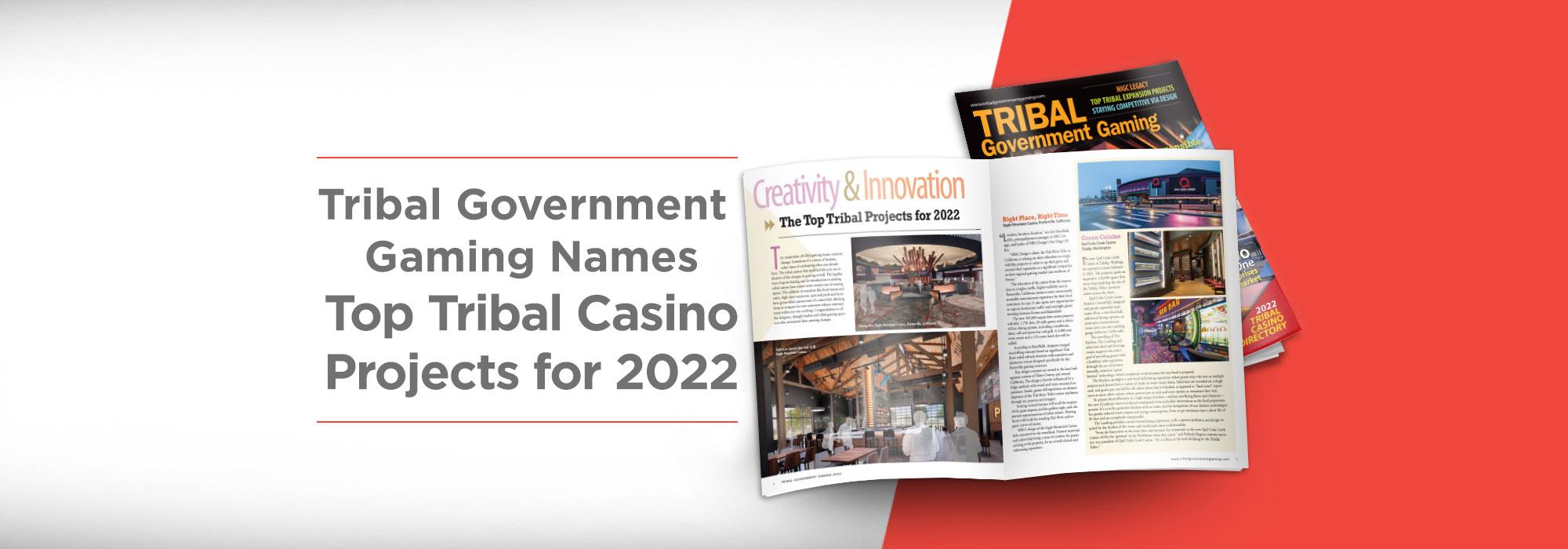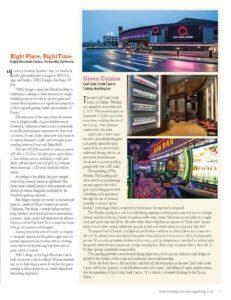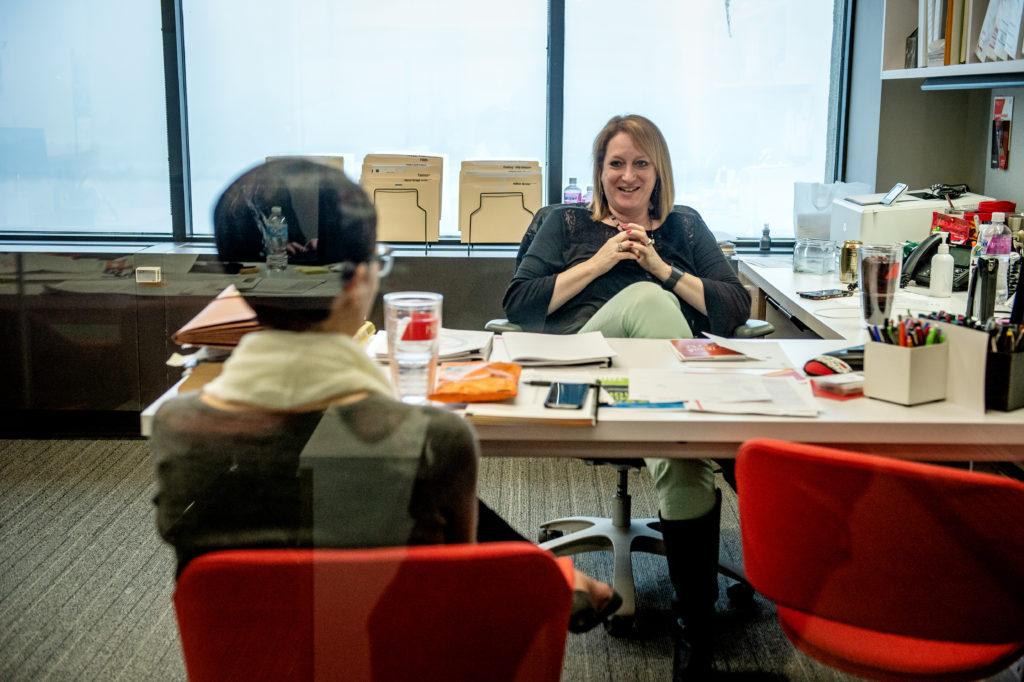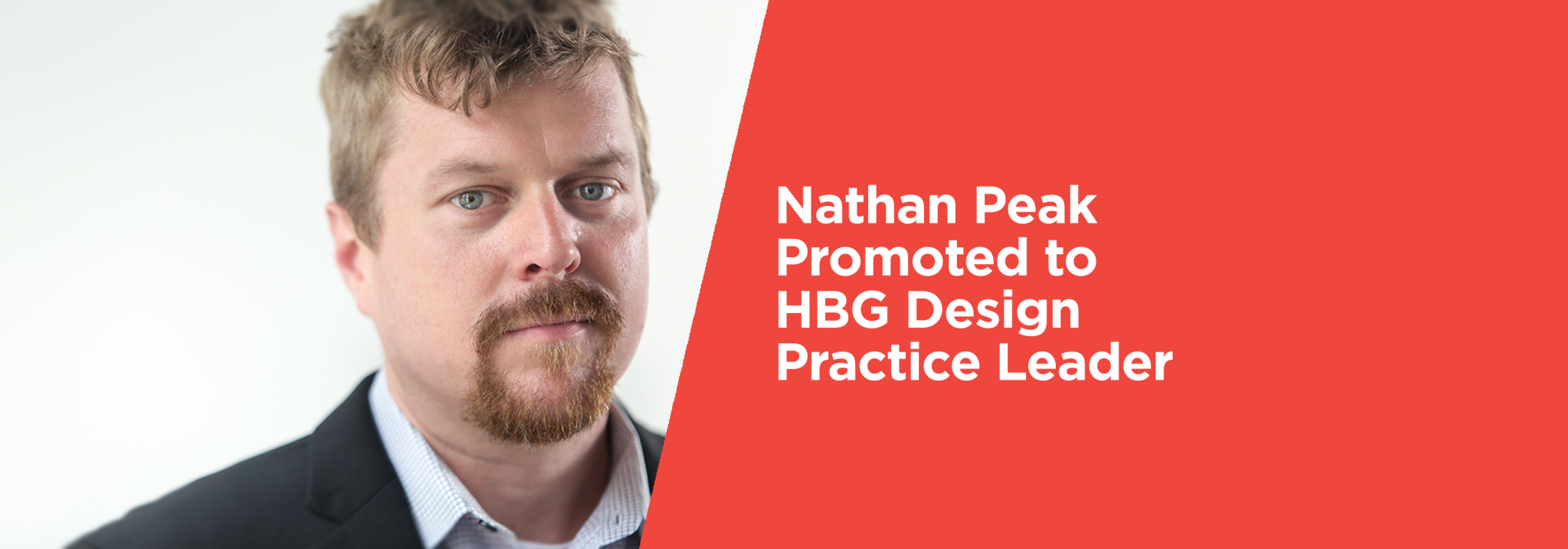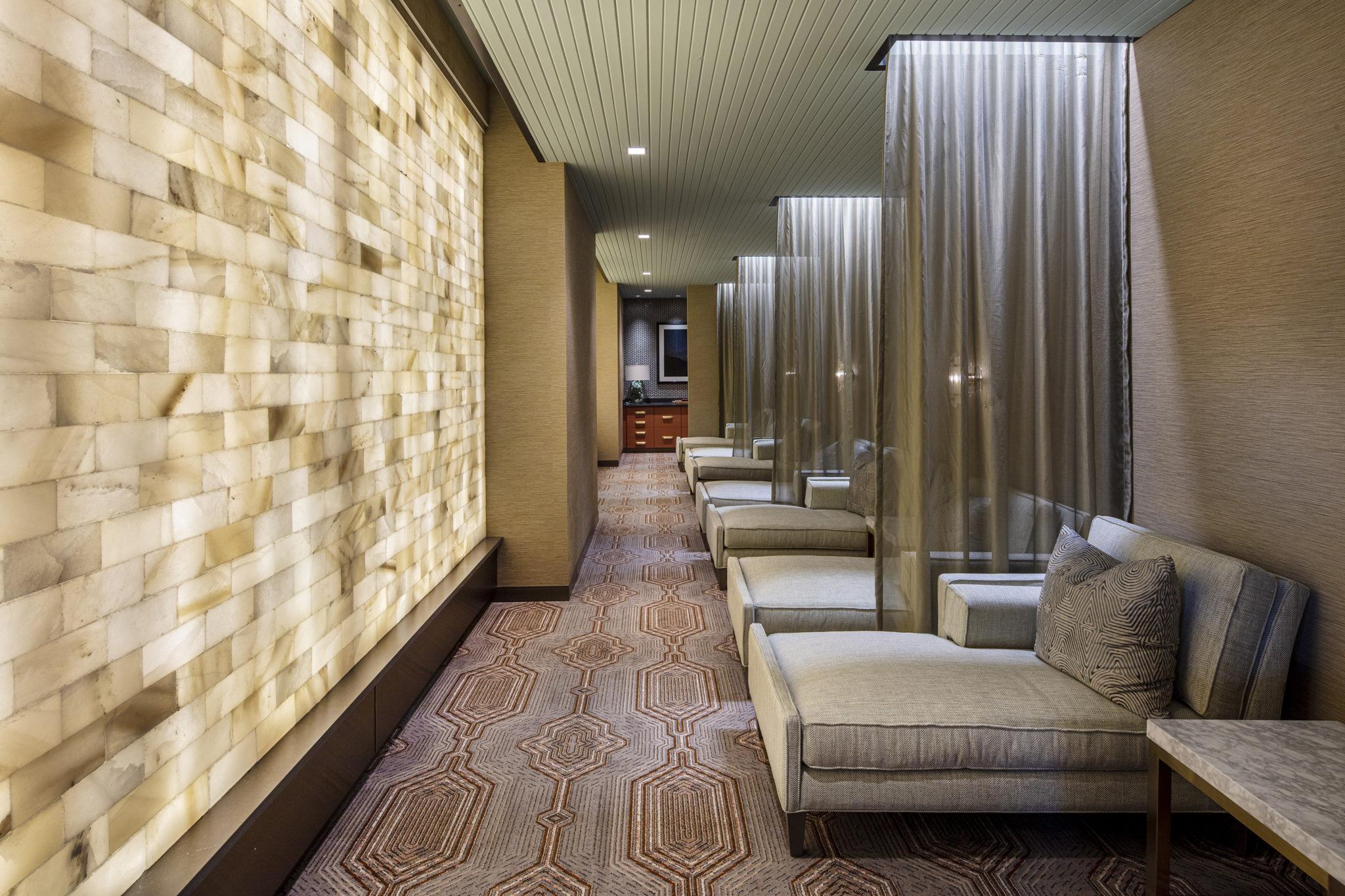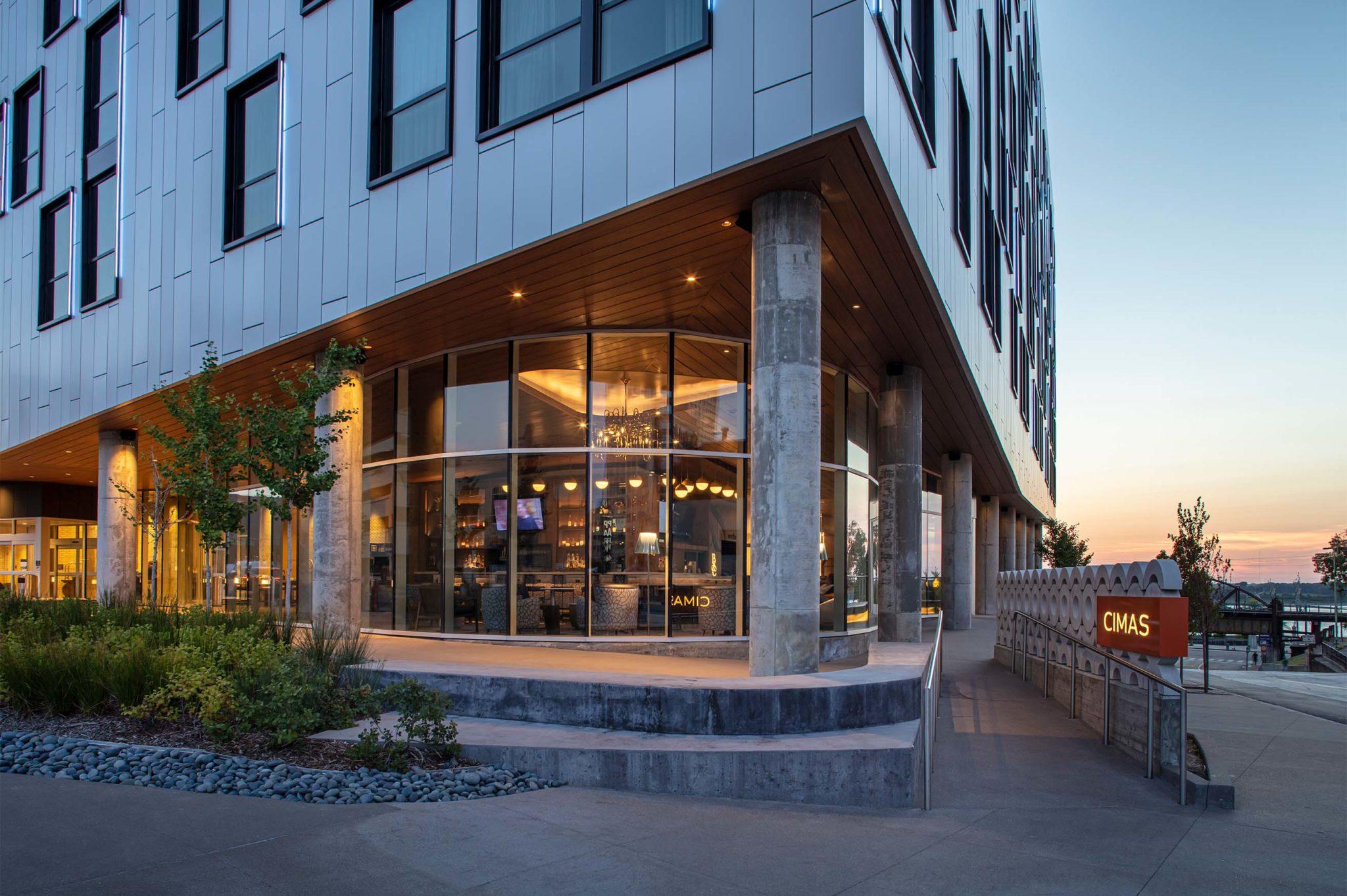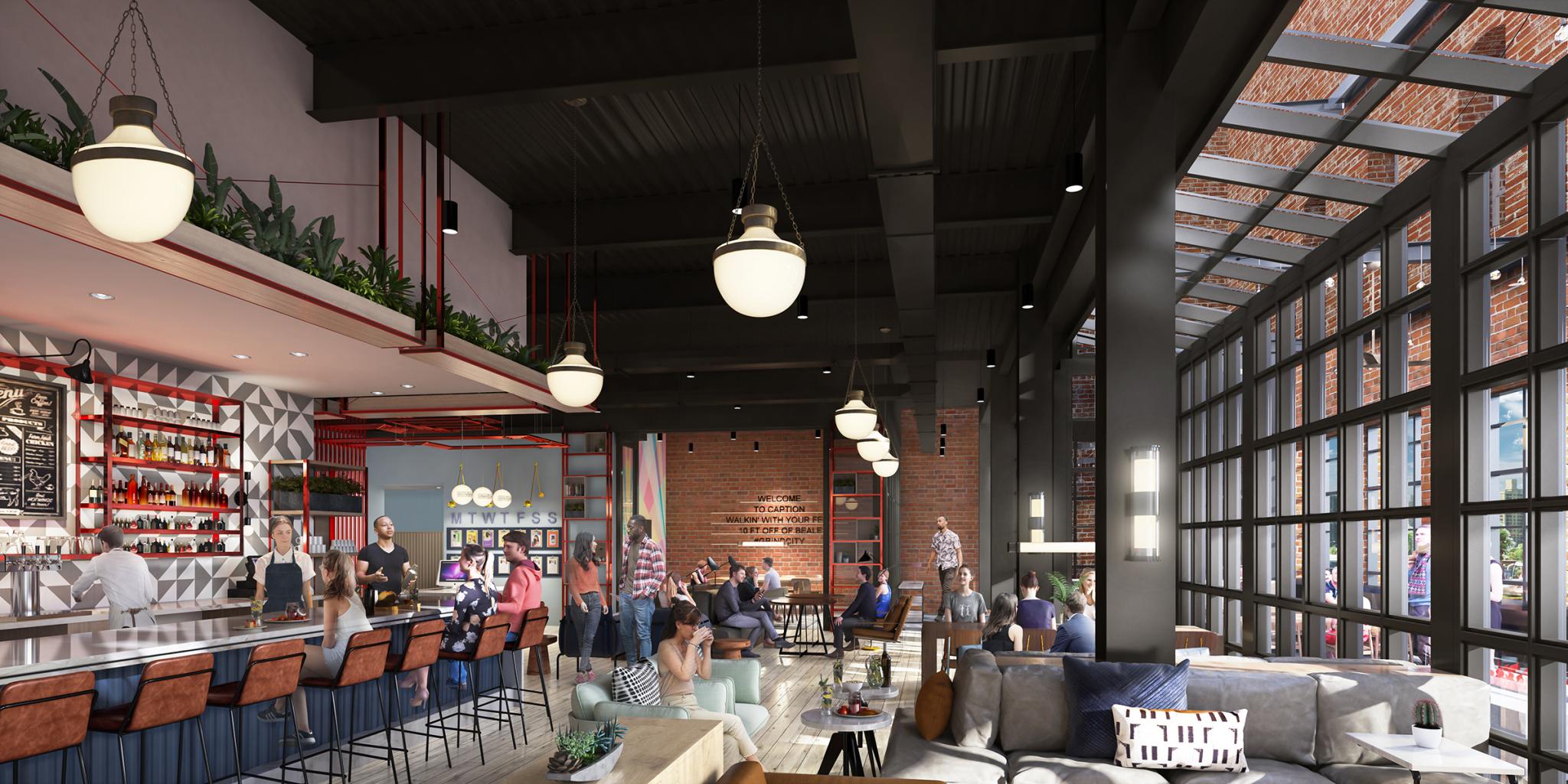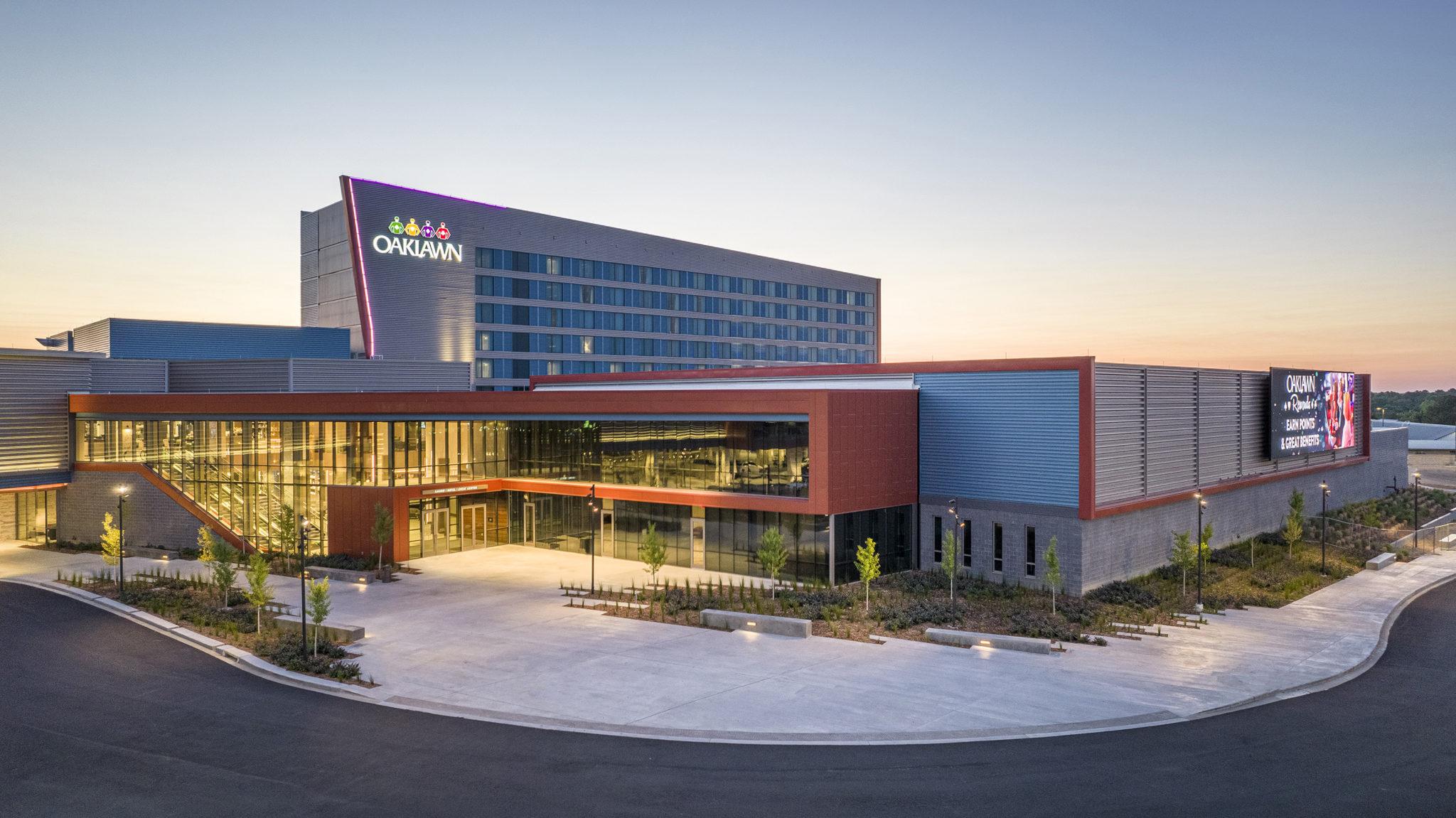Astral Spa at Oaklawn Racing Resort Featured in 'Spa Business' Magazine
See full article in Spa Business Magazine
Interior Design by HBG Design.
Astral Spa inspired by Roaring 20s opens in historic Hot Springs National Park
21 APR 2022 . BY MEGAN WHITBY
Celebrated as one of America’s most popular spa destinations, Hot Springs National Park in Arkansas has gained a new spa and wellness destination.
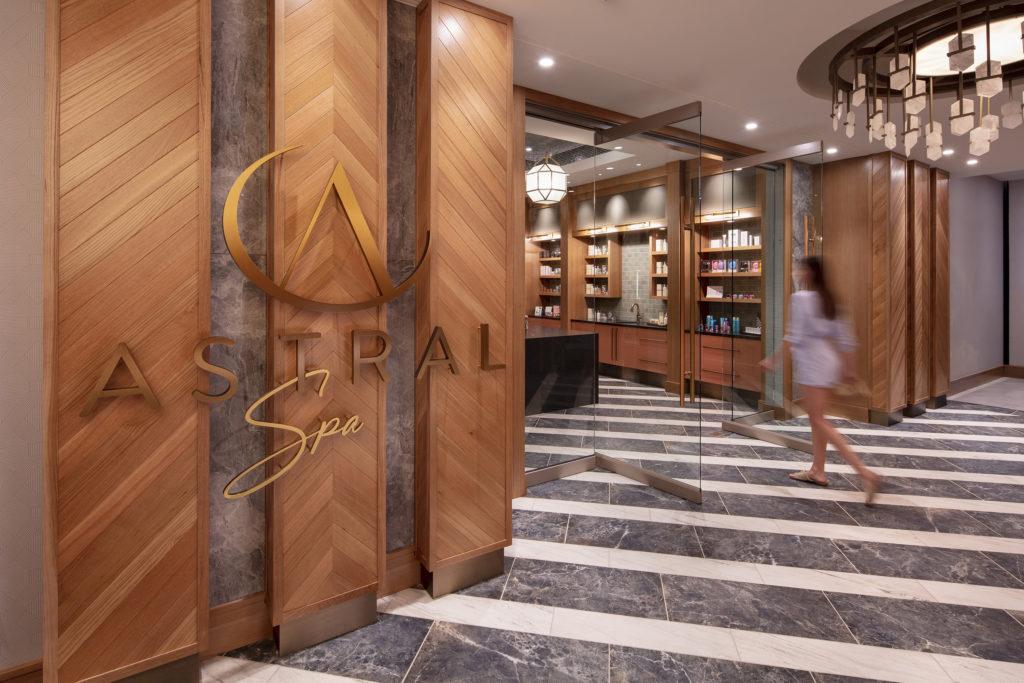 The new 8,000 sq ft Astral Spa has opened at Oaklawn Racing Casino Resort and has been designed with a nostalgic ambience inspired by the city’s past and Oaklawn’s history of thoroughbred horse racing.
The new 8,000 sq ft Astral Spa has opened at Oaklawn Racing Casino Resort and has been designed with a nostalgic ambience inspired by the city’s past and Oaklawn’s history of thoroughbred horse racing.
Hot Springs National Park is known for its 47 natural thermal springs and history of bathing, showcased by Bathhouse Row, a high street turned tourist hotspot with eight original bathhouses from the 19th- and 20th-centuries.
“Our vision was to create a unique spa experience that regional guests have never seen before,” says Oaklawn president Louis Cella, whose family has owned and operated the resort for over 100 years. “With multiple amenities, the spa offers a throwback vibe with modern luxury.”
Marrying crisp modern lines with historical overtures, Astral Spa’s design was led by HBG Design and WTS International. Spa consultant and operator WTS International also developed the spa’s treatment menu and is operating the spa.
“Relaxing in the lounges, we want our guests to imagine what Hot Springs was like in the Roaring 20s yet be in contemporary comfort,” adds Cella.
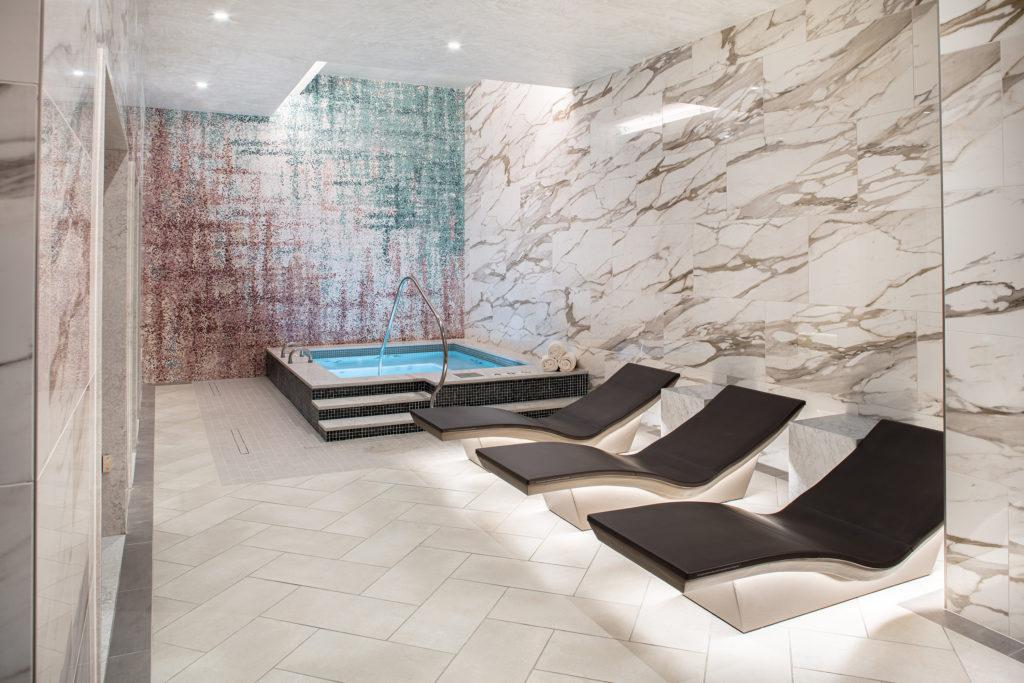 The guest journey begins in a reception area complete with an illuminated quartz crystal wall designed to reference the area’s history of crystal mining.
The guest journey begins in a reception area complete with an illuminated quartz crystal wall designed to reference the area’s history of crystal mining.
The spa then splits into separate female and male spas each with distinct parlours, changing rooms and thermal lounges featuring vintage-inspired 360-degree vintage-inspired needle showers.
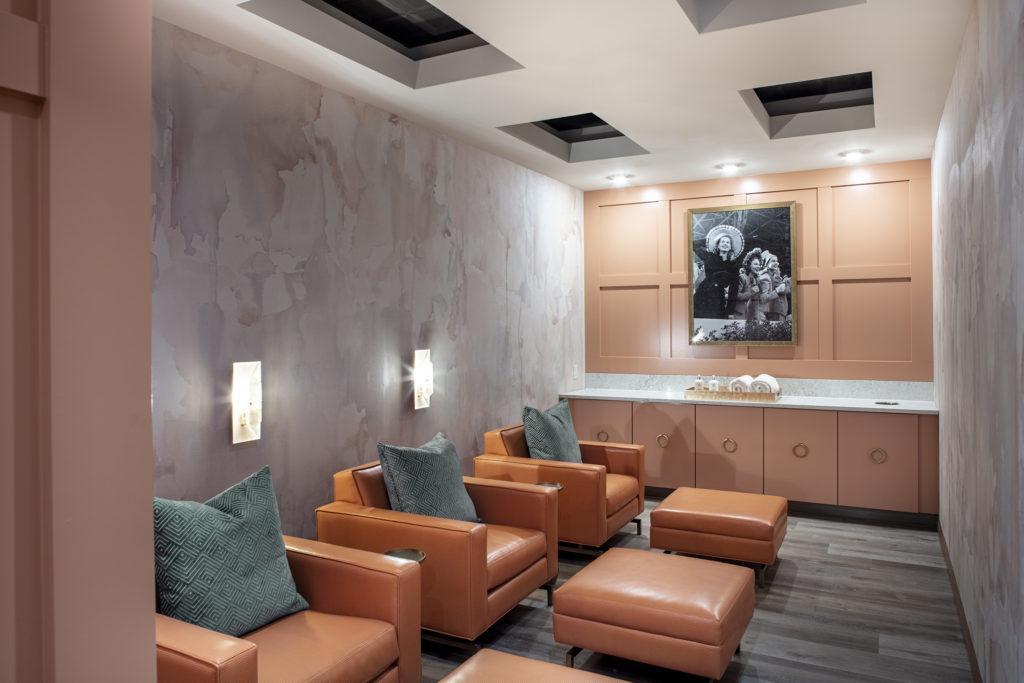 Both areas are equipped with contrast bathing circuits where guests can cycle through steamrooms, infrared saunas, ice lounges, vitality pools and thermal lounge areas.
Both areas are equipped with contrast bathing circuits where guests can cycle through steamrooms, infrared saunas, ice lounges, vitality pools and thermal lounge areas.
Guests can also relax in the open air at either the spa’s new outdoor pool with cabanas or outdoor event lawn.
The offering is rounded out with a 750 sq ft salon and a co-ed lounge with upholstered chaise lounges and a Himalayan salt wall. A fitness center equipped with LifeTime Fitness equipment is also on offer.
“Leading the design of The Astral Spa has been a career highlight, having grown up in a small town about 20 minutes from Oaklawn,” says Landon Shockey, IIDA, NCIDQ, lead interior designer at HBG Design. “I remember touring Bathhouse Row when I was younger and being absolutely intrigued by those grand spa spaces. To be able to return to Hot Springs and work with Louis and Rochelle Cella to create a modern-day bathhouse spa was a dream come true.”
“Thoughtful design, attention to detail and visual sophistication – these are the drivers of today’s experiential luxury, and that’s what the team achieved in the Astral Spa’s design,” says Emily Marshall, IIDA, NCIDQ, principal and interior design director at HBG Design.
“It’s less about opulence and more about wellness and the way a space makes the guest feel, with more authentic, locally-inspired design features and smart design touches.”
Click to see more about Astral Spa at Oaklawn Racing Casino Resort.
New Four Winds Casino New Buffalo Sportsbook Lounge is Designed for Comfort
Four Winds New Buffalo Casino Resort's newest amenity, the Sportsbook Lounge made the cover of the latest Tribal Government Gaming issue and was prominently featured in the "Sports of All Sorts" article. A small excerpt is below.
Sports of All Sorts
By: Roger Gros
See full article in Global Gaming Business' Tribal Government Gaming issue
https://issuu.com/globalgamingbusiness/docs/tribal_government_gaming_2022
Retail or Mobile
A retail book will soon become a staple for tribal casinos as sports betting continues to grow across North America. There’s really nothing like the excitement of an NFL Sunday or March Madness inside your casino when players can bet money on the games.
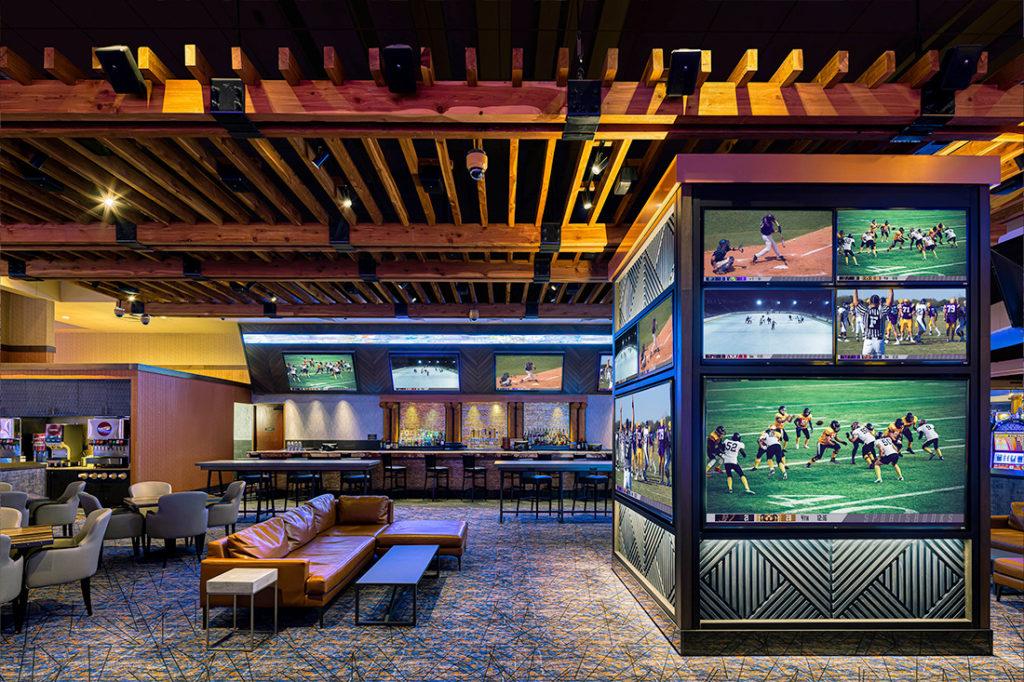 Most tribal sportsbooks won’t look anything like the Superbook at the Westgate in Las Vegas or the world’s largest sportsbook at the Circa in Downtown Las Vegas. But that doesn’t mean the excitement level will be anything less.
Most tribal sportsbooks won’t look anything like the Superbook at the Westgate in Las Vegas or the world’s largest sportsbook at the Circa in Downtown Las Vegas. But that doesn’t mean the excitement level will be anything less.
When HBG created the sportsbook at the Four Winds casino in New Buffalo, Michigan, it was designed for comfort. The Sportsbook Lounge is adjacent to the casino floor to take advantage of the surrounding gaming excitement. It’s designed to be a comfortable yet active retreat where guests can watch football, basketball, baseball and hockey action, while never having to leave the gaming floor environment.
The lounge’s custom layout and design provide sports fans with a comfortable ambiance to enjoy a beer while cheering on their favorite teams on any of the venue’s 22 televisions. Above the bar and on a large-scale central column are eight 85-inch, six 65-inch and eight 43-inch screens for ideal viewing from sectional sofas and lounge chairs, casual dining tables with chairs, and bar stool seating at the large sports bar.
Frank Freedman, chief operating officer of Four Winds Casinos, says the response of the customers has been very positive.
“We feel the layout, design and finishes will provide guests with the right ambiance, comfortable seating options and splendid views of multiple screens to enjoy a refreshing beverage or cocktail while cheering for their favorite teams,” he says. “Every addition we’ve made to our Four Winds Casinos locations has been for the sole purpose of enhancing the guest experience, and we’re thrilled to be able to offer this new amenity at Four Winds New Buffalo.”
Eagle Mountain Casino Named Top Tribal Project for 2022
See full list of Top Tribal Projects for 2022 in Tribal Government Gaming
HBG Design is excited to share that Tribal Government Gaming Magazine has selected Eagle Mountain Casino in Porterville, California as a Top Tribal Project for 2022.
Creativity & Innovation
The maturation of tribal gaming means constant change. Sometimes it’s a move of location, other times it’s enhancing what you already have. The tribal casinos that qualified this year are indicative of the changes in gaming overall. The legalization of sports betting and its introduction to existing tribal casinos have meant some creative use of existing spaces. The addition of amenities like hotel rooms and suites, high-class restaurants, spas and pools and more have given tribal casinos more of a resort feel, allowing them to compete for new customers whose entertainment wallets are ever-evolving. Congratulations to all the designers, thought leaders and tribal gaming operators who envisioned these amazing changes.
Right Place, Right Time
Eagle Mountain Casino, Porterville, California
Location, location, location,” says Joe Baruffaldi, AIA, principal/project manager at HBG Design, and leader of HBG Design’s San Diego Office.
“HBG Design’s client, the Tule River Tribe in California, is relying on their relocation to a high-visibility property in order to up their game and cement their reputation as a significant competitor in their regional gaming market just southeast of Fresno.”
The relocation of the casino from the reservation to a higher-traffic, higher-visibility area in Porterville, California creates a more conveniently accessible entertainment experience for their local customers, he says. It also opens new opportunities to capture destination traffic and overnight guests traveling between Fresno and Bakersfield.
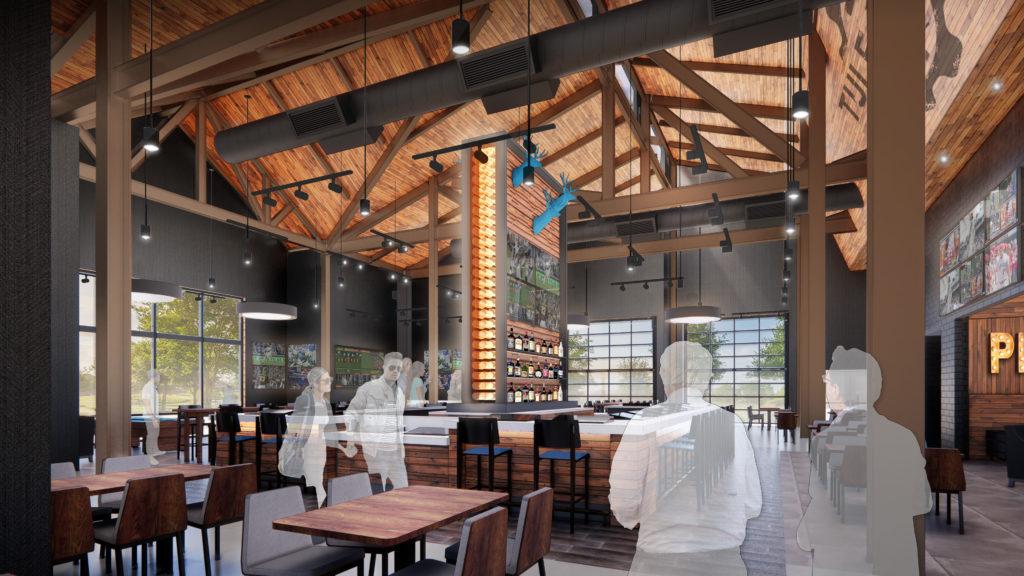
The new 105,000-square-foot casino property will offer 1,750 slots, 20 table games and a choice of four dining options, including a steakhouse, diner, café and sports bar and grill. A 2,000-seat event center and a 125-room hotel also will be added.
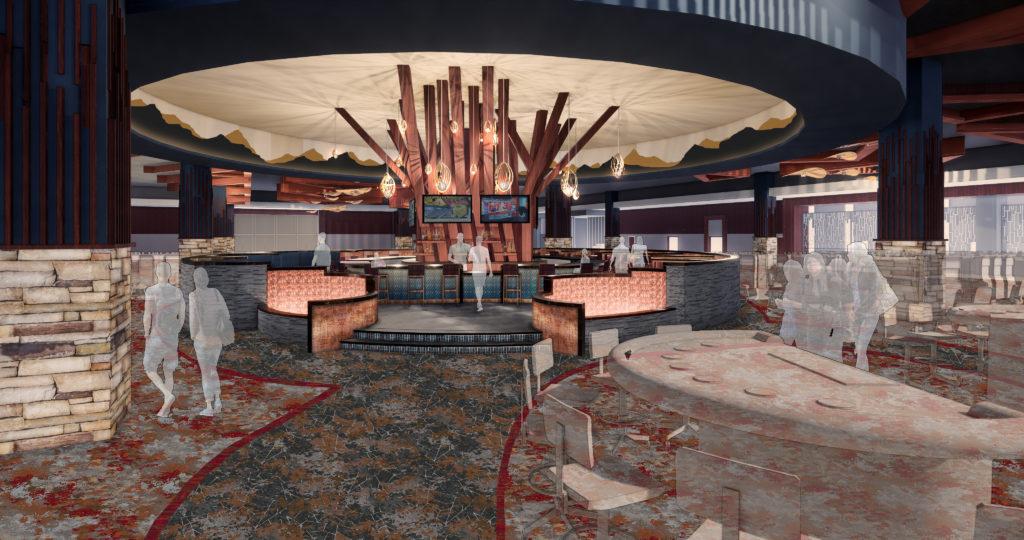
According to Baruffaldi, designers merged storytelling concepts based on significant Tule River tribal cultural elements with amenities and distinctive venues designed specifically for the Porterville gaming customer.
Key design concepts are rooted in the land and agrarian context of Tulare County and central California. The design is heavily influenced by a lodge aesthetic with wood and stone structural expressions. Inside, guests will experience an abstract depiction of the Tule River Tribe’s native traditions through art, patterns and imagery.
Soaring vertical features will recall the majesty of the giant sequoia and the golden eagle, each important representations of tribal culture. Flowing forms will recall the winding Tule River and organic curves of nature.
HBG’s design of the Eagle Mountain Casino feels connected to the woodland. Natural materials and colors help bring a sense of comfort for guests arriving at the property, for an overall relaxed and welcoming experience.
https://issuu.com/globalgamingbusiness/docs/tribal_government_gaming_2022
Tribal Gov't Gaming: Indian Gaming is Bouncing Back
See full article in Tribal Government Gaming
by Dave Bontempo
Tribal projects and gaming revenues rebound in the post-pandemic world
Bring back the aggressive gaming approach.
Tribal leaders and design firms say the “be-safe” phrase is morphing into “go-big” for the new post-pandemic world. Pent-up demand meets the resumption of competition, requiring tribal leaders to perform a balancing act. Operators seek the sweet spot incorporating must-see attractions, comfortable environments and realistic budgets.
As the American market emerges from Covid-19, projects become more forward-looking, far-reaching and sophisticated. Some of the nation’s most prominent companies help tribal leaders step forward.
Project Optimism
HBG Design unveils several operations with tribal leaders positioning themselves both for near-term and long-term success. Dike Bacon, principal, notes that U.S. commercial gaming revenues set an all-time record in gross revenue of $53 billion in 2021.
If this is any indication of the health and vitality of the Indian gaming industry (NIGC has not released 2021 figures), business is booming, he says. “Visit any casino in almost any domestic market and customer traffic is extraordinarily strong—inflation notwithstanding—and you see that demand is there,” he says.
Drivable trips are answering the call of most travelers’ curiosity, which has fueled the need to create fresh and exciting offerings in regional markets where many tribal casinos are located, he adds.
“Competition and location are often the driving forces behind whether a property needs a ‘must-see attraction’ as a differentiator and a draw, but any such ‘wow factor’ has to align with the property’s brand and target audience,” Bacon says.
“I’ll give you an example—we’re designing a distinctive feature attraction for events, music, daytime leisure and active nightlife, as part of a tribal casino resort expansion. The property has a formidable reputation as a leading entertainment and gaming destination, located within 30 miles of a metro feeder market of over 1 million people.
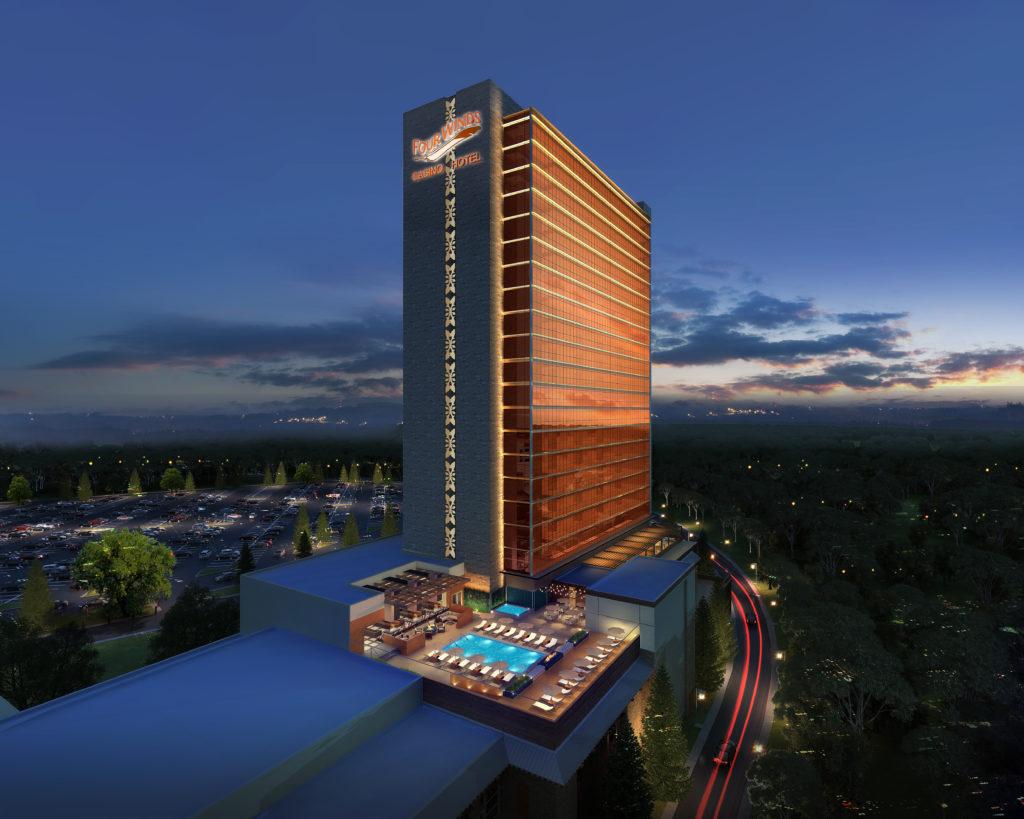
“Properties like this are able to support large-scale, high-impact, must-see attractions when their location combines a vibrant, diverse local population base and access to an equally strong destination customer who is willing to drive farther and stay longer to experience a distinctive amenity that is unmatched in the regional market.”
Bacon says HBG seeks innovative ways to help clients do more with less.
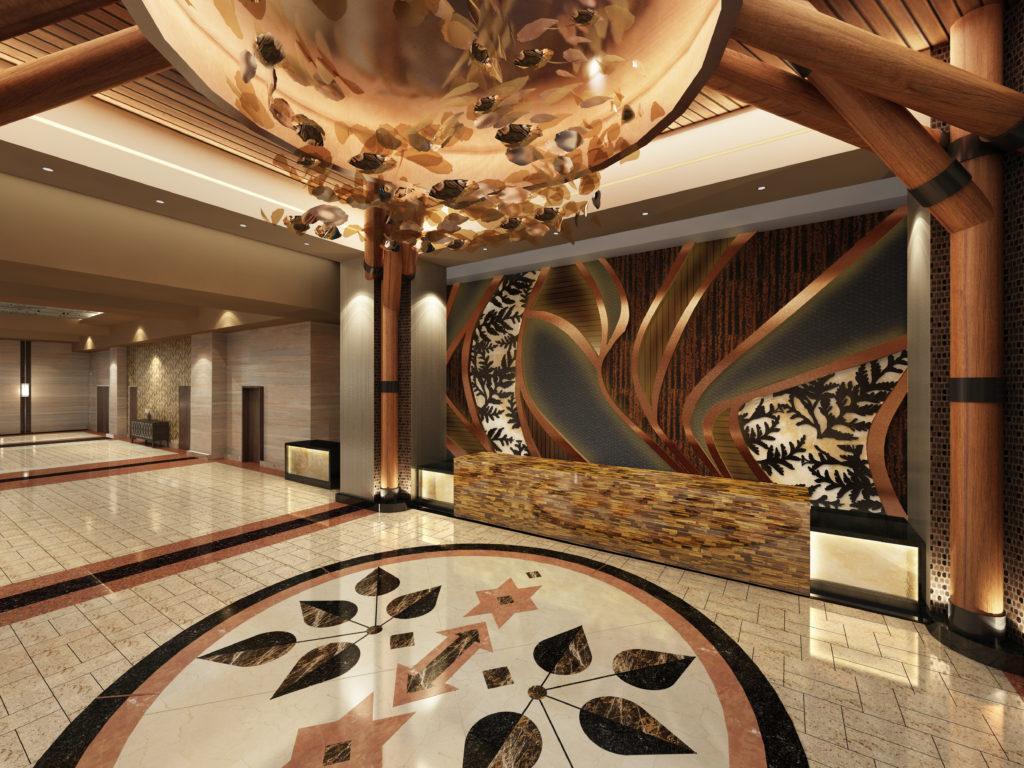
“This challenge covers a lot of ground, from designing public spaces and guest rooms that are easier and faster to clean and service to moving towards automation in concierge and casino hotel check-in,” he says. “Clearly, one of the biggest challenges for operators is to capitalize on current demand while still offering a great entertainment and hospitality experience with impressive customer service. Staffing in the entire hospitality industry (not just gaming) has been incredibly challenging.”
HBG designers work alongside owners to address these pressing issues. This includes creating more efficiently designed spaces that are exciting and entertaining but can also be operated with less staff.

“We’re creating more efficient kitchens and more diverse means of providing F&B to customers, including self-service and take-out venues. Valet parking is another key service area affected by staffing shortages,” says Bacon.
“More customers may be encouraged to self-park instead of valet, which means designing and locating parking garages that are more convenient, secure and customer-friendly. It also gives rise to designing more elevated and exclusive VIP entrance experiences reserved for a property’s best players, creating a smaller staffing pool to focus service on the largest contributors to the casino’s bottom line.”
Nathan Peak, AIA, LEED GA, practice leader/principal of HBG Design, says pent-up demand for entertainment and hospitality experiences motivate tribes to upgrade underperforming areas of their facilities.
“Given the performance of the industry and how it is bouncing back from the pandemic, we are confident that owners will remain in expansion and renovation mode for a while,” Peak says. “A client recently told us that their gaming resort property will likely be in a continuous state of evolution, renovation and building over the next several years to stay fresh for guests and maintain relevancy in the market.”
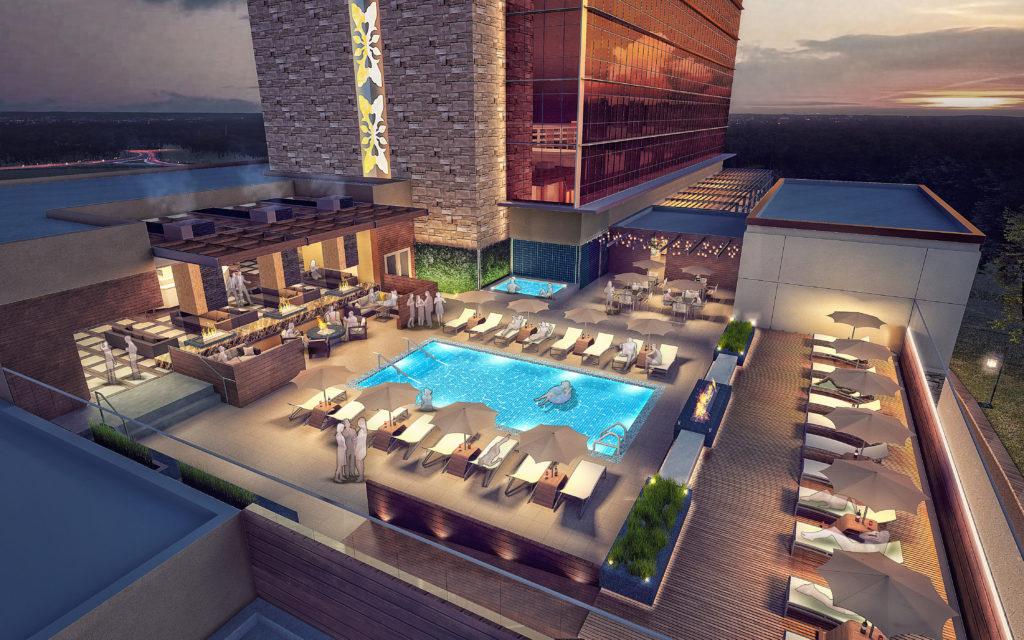
Another major influencer of the “continuous state of evolution” mindset is the continued passing of new legislation that drives change in tribal—and commercial—gaming properties, says Peak. As more states pass sportsbook legalization, that sets up new priorities for gaming properties who need “must-have” amenities to compete.
Tribes Take Assertive Stance
“Tribal gaming is definitely staying aggressive in terms of maintaining market share, especially in areas of the country where commercial gaming is growing and evolving,” adds Joe Baruffaldi, AIA, principal/project manager at HBG Design, and leader of HBG Design’s San Diego office.
“Tribes realize that knowledge is power; it’s what fuels a competitive edge,” he says. “There’s a greater need today for tribal casino owners to understand the nature of their customer base and harness the power of that knowledge—appreciating and leveraging not only where guests are coming from, but who they are as consumers.
“We partner with tribal gaming clients by helping them envision what the ‘tomorrow of their market’ looks like. When we’re able to anticipate changes in the marketplace, we can proactively respond by leading our clients to more competitively positioned design solutions.”
One of the highlights for HBG over the last few years has been its involvement in in the Four Winds South Bend casino in Indiana. The property is owned by the Pokagon Band of Potawatomi Indians, which operates three other casinos in Michigan.
Four Winds Casino embarks on a large-scale expansion of its South Bend property, designed by HBG, offering approachable luxury within a new 23-story, 317-key, 83-suite hotel tower.
The project includes a mix of vibrant amenities, to include a spa, convention area, meeting space, a ballroom, lounge, bar and grill, an outdoor rooftop swimming pool, and terraces with spectacular views.
The design incorporates regional elements and warm, rustic details with special attention and references to tribal influences and symbolism.


https://issuu.com/globalgamingbusiness/docs/tribal_government_gaming_2022
HBG Design's 'Women Who Lead' Honored by Memphis Business Journal
See full article in Memphis Business Journal
HBG Design is excited to share that our Chief Operating Officer, Terri Struminger and Director of Marketing and communications, Tamara Goff have been honored by Memphis Business Journal's editorial team as "Women Who Lead". This prestigious recognition highlights accomplishments of women who have broken through the glass ceiling and helped define their businesses, as well as the local marketplace.
Women Who Lead | Architecture: Terri Struminger of HBG
Terri Struminger not only acknowledges the rarity involving her role, but she champions it too. And rightfully so. She’s not an architect, though she’s successfully running the operations of HBG Design. “That’s been a very intentional hallmark of HBG’s organization for the past three decades,” she explained. Struminger leads the fully capable corporate operations team, so their “architects and interior designers are able to do what they love and do best: practice their craft, service our clients, and create exceptional projects.”
Next up on her agenda is leading new strategies and processes that integrate HBG’s core vision into every aspect of their team’s professional and personal development. Another big goal is to deepen employee engagement by rebooting some of the interactive aspects of our culture that have been altered because of the pandemic. “I am passionate about creating a ‘Best Place to Work’ culture at HBG Design,” she added, “and that sense of purpose drives absolutely everything I do.”
“I believe if you can share your organization’s values and priorities effectively, you can drive engagement in your workforce. With that in mind, my team and I set out on a journey to build greater awareness of our strategic vision and goals across the firm. I’m proud of the role I’ve played spearheading the evolution of HBG’s core vision. This has been a multiyear initiative that, so far, has clearly ignited a deeper connection between employees, firm aspirations, and culture.” - Terri Struminger, COO, HBG Design
Women Who Lead | Marketing: Tamara Goff of HBG Design
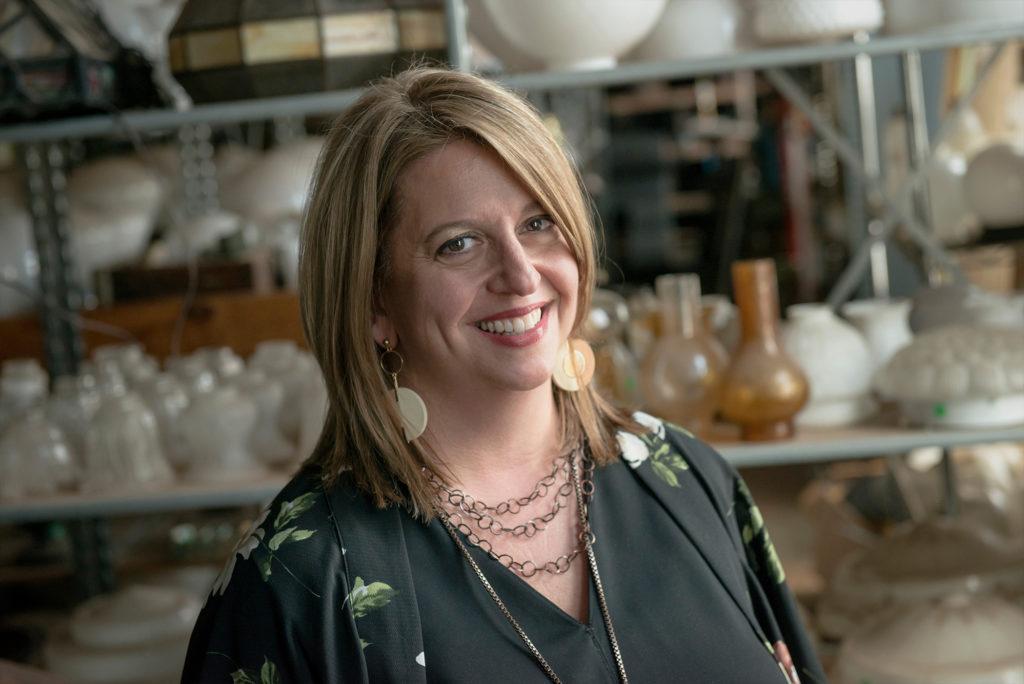
With more than two decades leading marketing efforts at HBG Design, Tamara Goff has a combination of skill sets that can often defy description. “What I do isn’t conventional. I’m a combination brand alchemist, creative influencer, communication ninja, aspiring novelist, culture curator, head cheerleader, and occasional cat wrangler,” Goff said. “Our CEO also tends to refer to me as ‘part of the conscience of the firm.’” More specifically, Goff is a principal and shareholder at HBG with a focus on influencing creative and strategic outcomes for the architecture firm. She points to the credibility established for her team in the industry, having garnered more than 30 national and international marketing and communication awards. And rebranding the firm to HBG Design in 2016 was a significant centering of the firm on its ‘true north’ and identity.
Nathan Peak Announced as HBG Design Practice Leader
Nathan will be focused on influencing design innovation, nurturing talent and leading HBG’s teams in delivering impactful hospitality design.
January 12, 2022 - Memphis, TN – HBG Design announces Nathan Peak, AIA, LEED GA, has been named Practice Leader of the 100-person, top 10 nationally recognized hospitality design and architecture firm. In his new role, Peak will oversee design and practice leadership for HBG’s three offices in Memphis, TN, San Diego, CA, and Dallas, TX. His promotion to Practice Leader represents the initial step in HBG Design's transition to its third generation of firm leadership.
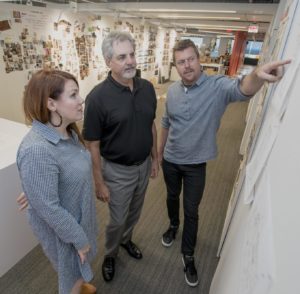
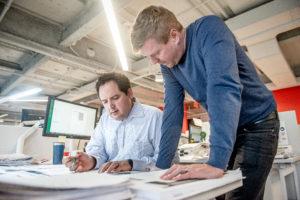
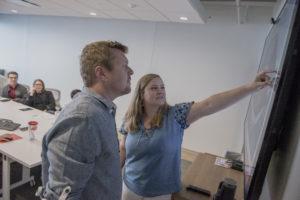
Peak is a principal in HBG Design's Memphis headquarters. Of his 20+ years with the firm, Peak has served as HBG’s Design Director for nearly a decade, leading and guiding the design direction of the firm’s national hospitality and entertainment projects.
“Nathan continues to be a transformative leader with immense creative vision and ambition for the firm’s growth,” says Rick Gardner, AIA, CEO of HBG Design. “He’s a champion of award-winning, experiential design and has a gift for cultivating talent and deepening the connections between employees across our organization.”
Peak plans to build on the firm’s deep bench of talented professionals to further position HBG Design’s national presence into multiple sectors of the hospitality industry.
“I’m energized by this generation’s sense of passion and purpose," says Peak. "I look forward to bringing a level of design leadership to the firm that is keenly focused on encouraging and engaging others to create something meaningful and impactful for our clients and those who experience the spaces we create.”
A core principle of HBG Design’s culture and vision is represented by the term ‘Ensuring Longevity.’
As HBG’s COO Terri Struminger describes, “We have a very distinct culture that connects our people and purpose and gives us opportunities to rally around common goals. One way we achieve longevity for HBG Design, our employees and their families is through smart transition planning that maps a clear path from the current generation of leaders to the next. Nathan’s elevation to Practice Leader is a significant moment on our path.”
An active father of a 13-year-old daughter and a 9-year-old son, the new face of HBG’s design practice knows first-hand the challenges of work-life balance facing today’s professionals.
“Like so many of our employees, I also balance bringing my absolute best to support our clients and the needs of our team – while managing a busy schedule of soccer tournaments and just being a dad,” says Peak. “I believe that a key aspect of corporate culture is keeping our work interesting and challenging, while enhancing work-life flexibility. We don’t just bring a part of ourselves to work each day – we bring our whole self. My goal is to really nurture an environment where everyone can bring their full life experience to what they do and know they are contributing something unique and important to the big picture.”
Peak is a graduate of the Pratt Institute in New York City where he earned his Bachelor of Architecture degree. He joined HBG Design in September 2001 as an architectural designer. His innovative hospitality and entertainment designs prominently stand out in the marketplace and have received national acclaim and multiple industry awards.
Astral Spa at Oaklawn Honored by Fay Jones Alumni Design Awards
See full list of winners posted by University of Arkansas
The Fay Jones Alumni Design Competition awarded an Honorable Mention to the Astral Spa at Oaklawn Racing Casino Resort.
The first new spa built in Hot Springs in more than a century, Astral Spa provides Oaklawn guests with a modern-day 'bathhouse' spa experience.
Designers united modern health and wellness concepts with elements inspired by the city's Bathhouse Row.
Jurors noted, "Gleaming tile, the complex stone textures and subtle lighting strategies contributed to the unique experience in each of the service areas. All the choreographed movements provide both privacy and inform the tempo of the overall guest experience. Well done."
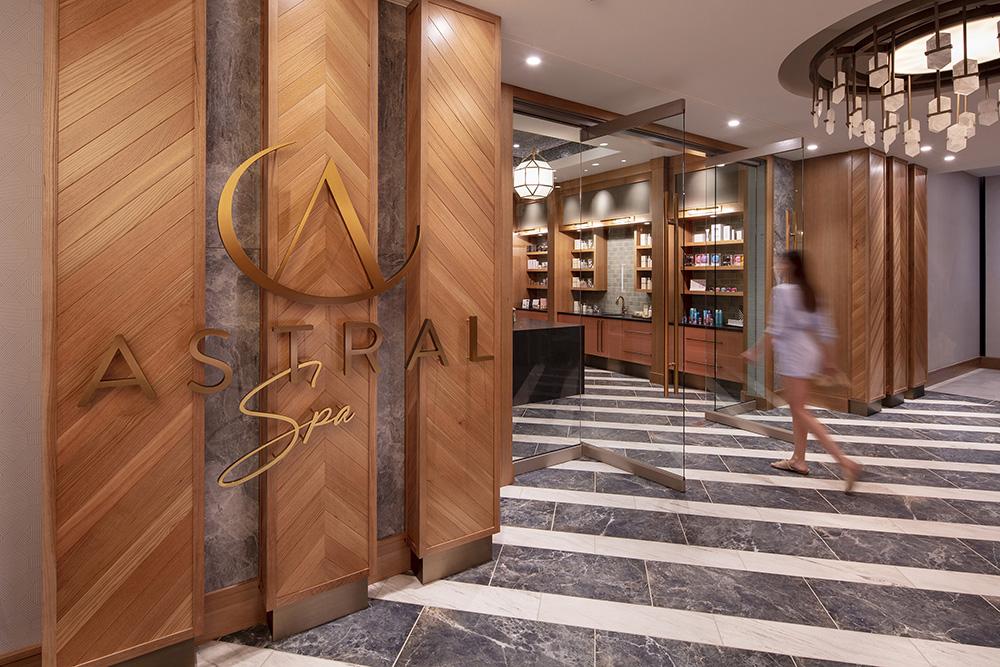
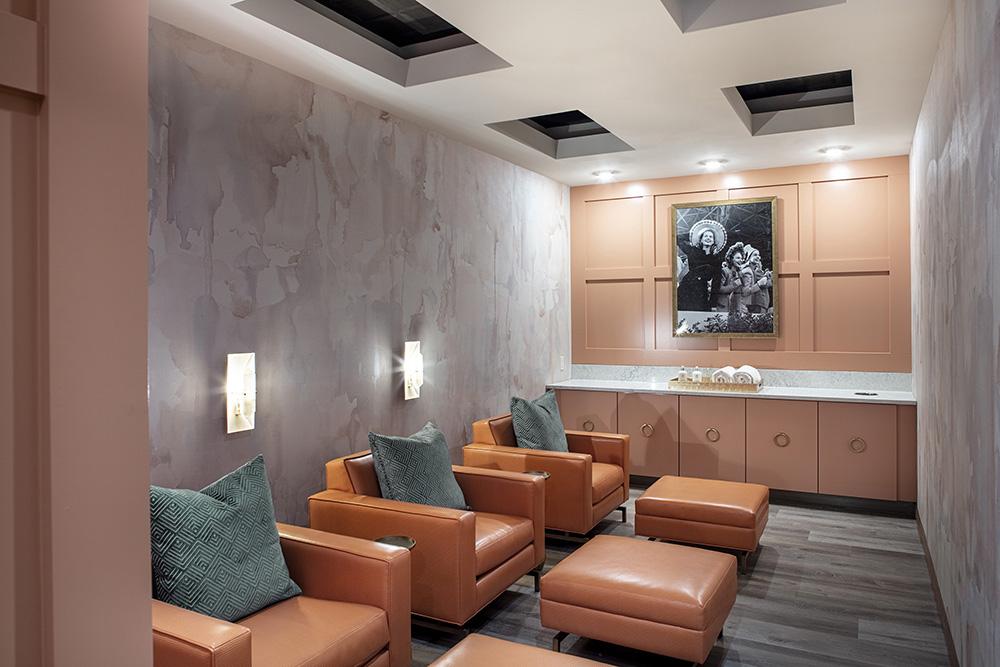
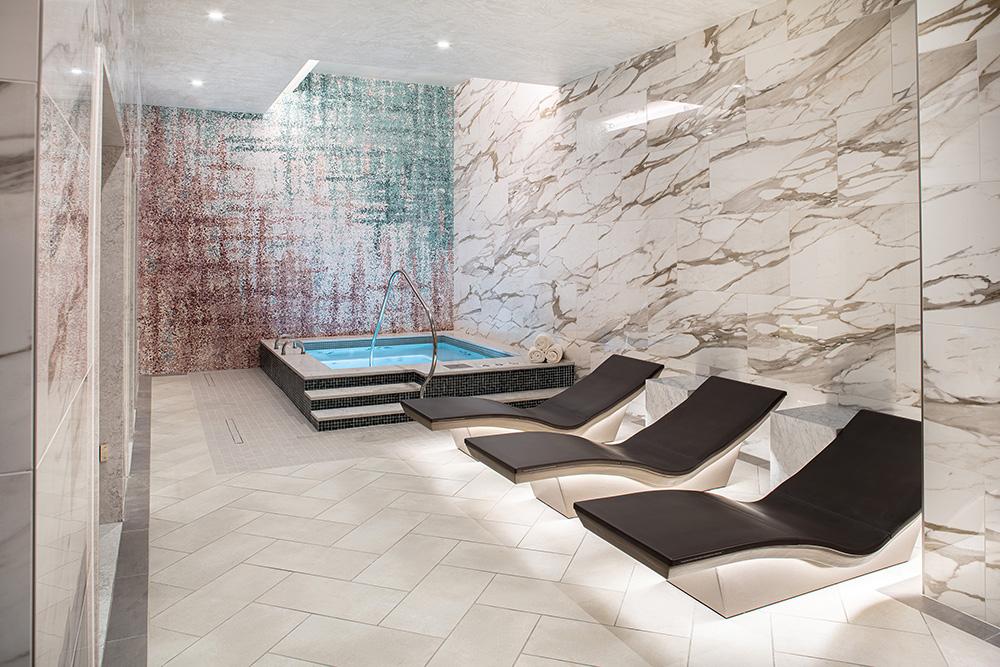
ASTRAL SPA INSPIRATION
Hot Springs, Arkansas, was a favorite getaway for the rich and infamous in the early 1900s. Known as ‘The Spa City', the city was the birthplace of spa resorts in the U.S. Thermal spring waters and Victorian-era Bathhouse Row attracted early visitors. Horse racing at Oaklawn and hidden downtown speakeasies also drew crowds. Visitors still flock to Hot Springs to experience the city's history. Oaklawn Resort is offering modern amenities to complement the area’s entertainment. The Astral Spa is the first full-service spa to be built in 'Spa City' in 100 years. The 8,000 square foot spa provides a relaxed nostalgic ambiance that frames each guest’s spa journey through a complete sensory experience.
Click here to learn more about the Astral Spa at Oaklawn Racing Casino Resort.
Hyatt Recognizes the Hyatt Centric Beale Street with The Best New Property Award
See full list of honorees on Travel Daily News
CHICAGO – Hyatt Hotels Corporation awarded 32 owners, operators and developers at its 2021 America Owners Conference, held at Hyatt Regency Huntington Beach Resort & Spa in Huntington Beach, California.
“At Hyatt, we remain focused on our growth and we are both intentional and thoughtful about where we want the Hyatt flag raised. Our brand growth and success are a testament to our fellow owners, operators and developers, and we are immensely proud of the many longstanding relationships that we have throughout our industry, as well as new ones that we continuously cultivate,” said Jim Chu, Executive Vice President, Global Franchising and Development, Hyatt. “Leading with our purpose of care, we remain empathetic to the challenges that our owners and operators have experienced in recent months and we are truly appreciative of their commitment to maintaining and growing Hyatt’s brand portfolio. We are privileged to work with industry-leading owners, operators and developers and congratulate all of our award recipients.”
The Best New Property award recognizes notable full service and select service hotel openings:
 Full Service
Full Service
- Hyatt Centric Beale Street Memphis (Carlisle Corporation, LLC.): “One Beale,” a transformative five-acre multi-phased development, is the site of the beautiful Hyatt Centric Beale Street Memphis. As the first Hyatt Centric hotel in Memphis, the 227-room hotel offers a central location and Beale Street address, steps from the culture, food and nightlife that makes Downtown Memphis an iconic destination. Carlisle Corporation, LLC is also developing Caption by Hyatt Memphis, which is currently under construction within the One Beale development.
- Hyatt Zilara Cap Cana and Hyatt Ziva Cap Cana (Playa Hotels & Resorts): In 2013, Hyatt entered into an agreement with Playa Hotels & Resorts for the development of the Hyatt Zilara and Hyatt Ziva all-inclusive brands in Latin America and the Caribbean. Hyatt Zilara Cap Cana and Hyatt Ziva Cap Cana together comprise a 3,000-acre luxury master-planned community within Punta Cana in the Dominican Republic, offering more than 1,300 feet of beachfront on Juanillo Beach. Built by Playa Hotels & Resorts from the ground up, the combined 750-room Hyatt Zilara Cap Cana and Hyatt Ziva Cap Cana have a multitude of dining venues and leisure activities for families and adults, receiving numerous accolades as one of the best new all-inclusive resorts in the region.
- The Seabird, a Destination by Hyatt hotel, and Mission Pacific, a JdV by Hyatt hotel (SD Malkin): The Seabird and Mission Pacific are both beautifully programmed and designed – unique in their interpretation of the spirit and vibe of Southern California. They have been transformational in the impact that they have had on the local Oceanside community and there is no doubt that these two properties will be treasured by visitors and locals for many years to come.
- Alila Marea Beach Resort Encinitas (JMI Realty): Alila Marea Beach Resort is the third Alila hotel to open in the Americas. Situated along coastal bluffs with panoramic views overlooking Grandview and South Ponto Beaches, this luxury oceanfront resort in Encinitas, Calif. is distinguished by an innovative eco-design, a passionate commitment to sustainability and specially curated activities designed to immerse guests in nature, culture, and community, making it an outstanding representation of the Alila brand in North America.
- Thompson San Antonio (DC Partners): Located steps from the celebrated River Walk in San Antonio’s dynamic and evolving Arts District, the new Thompson San Antonio and The Arts Residences is a stunning addition to the River City. In February 2021, Houston-based DC Partners completed development of this landmark mixed-use project, which is a sophisticated modern-day interpretation of the rich history of this beloved Texas city. The hotel’s diverse and dynamic collection of culinary and bar venues span indoor and outdoor spaces and are sure to become a hub of activity for its guests and Arts District neighbors.
Caption by Hyatt Memphis on Top Hotel News 2022 Hotlist
2022 Hotlist: HBG Design's Caption by Hyatt Memphis Named One of Hyatt Hotels Corporation’s top three openings
The Unbound Collection, Caption by Hyatt and Hyatt Centric are all eagerly awaiting the arrival of eye-catching schemes next year, each of which draw on their surroundings for inspiration.
Caption by Hyatt Memphis
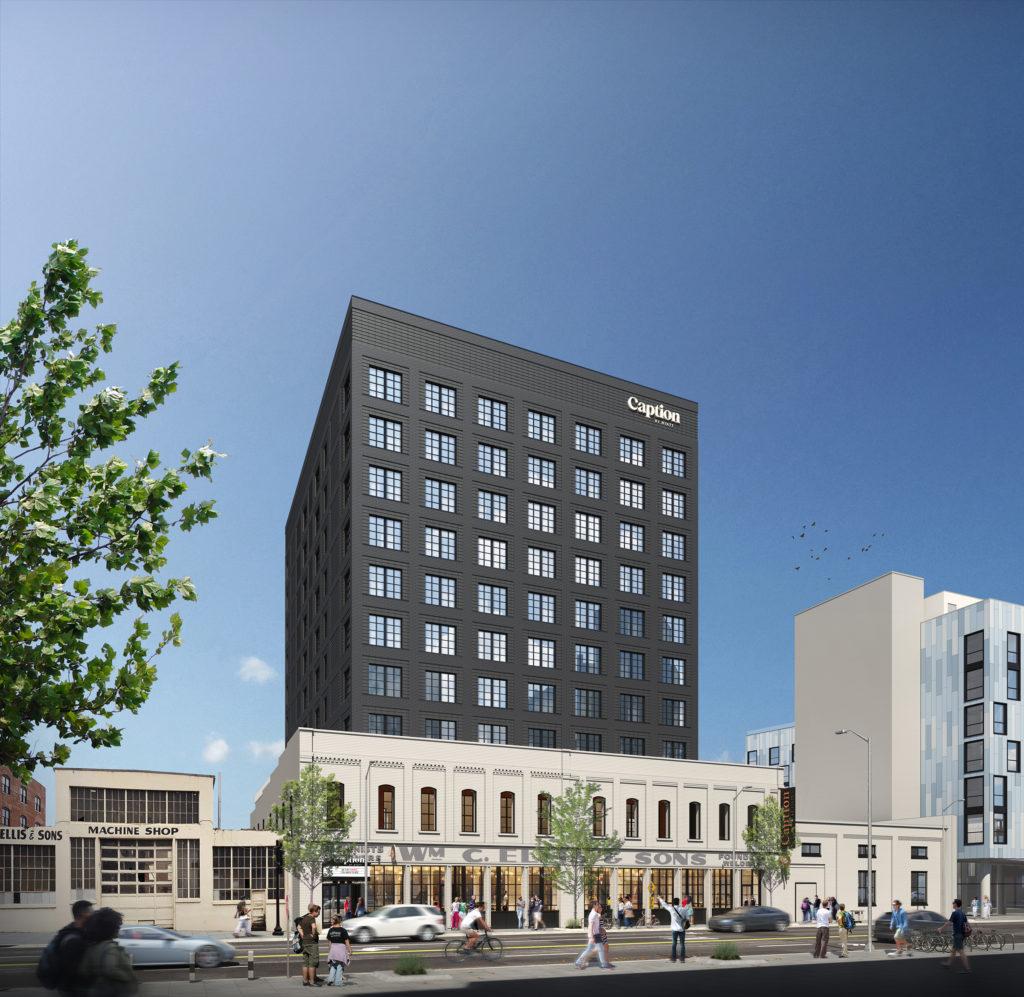
Currently under construction and expected to open in the second quarter of 2022, this new Caption by Hyatt hotel in Tennessee will encourage guests to embrace self-expression in a space focusing on experience and connection.
Hyatt is creating this 140-key property, which will be located at One Beale Street and integrated into the historic main building of Wm C Ellis & Sons Ironworks and Machine Shop, in partnership with Carlisle, while HBG Design is the architect and interior designer.
Caption by Hyatt Memphis will be located partly inside this heritage building and partly in a new guestroom tower, providing views of the Mississippi River and the city’s skyline.
Visitors will be encouraged to relax in the hotel’s multifunctional lounge space, Talk Shop, complete with original features, an expansive patio and a double-height beer garden with open firepits.
The Unbound Collection by Hyatt, Fuji Speedway, Japan
Hyatt Hotels Corporation is to provide a luxury hotel experience at Japan’s historic racing circuit, Fuji Speedway, after entering into a management agreement with an affiliate of Toyota Group for a proposed 120-key property.
Scheduled to open in Q3 2022, the under-construction newbuild scheme represents The Unbound Collection’s debut in Japan.
Amenities at The Unbound Collection by Hyatt, Fuji Speedway are to include multiple fine-dining restaurants, bars, a spa and natural onsen, a fitness centre and indoor pool, a banquet room and conference space.
Drawing on its setting, the property will also boast a car museum, showcasing rare vehicles and the racing circuit’s extraordinary history.
Hyatt Centric Kota Kinabalu, Malaysia
The 150-key Hyatt Centric Kota Kinabalu, which is being developed by Hap Seng Consolidated Berhad, will welcome guests to the heart of the city in a location that provides easy access to the commercial district, retail areas and countless restaurants, along with local attractions such as the Jesselton Point pier.
The architectural and interior design for this property is being led by Kengo Kuma & Associates, with inspiration taken from the lush green hills and blue ocean that characterise the area.
Notable amenities here are to include an all-day restaurant and lounge, a rooftop pool and bar, a fitness centre and 1,900 sq ft of meeting space.
Currently under construction, the hotel’s expected to open in the second quarter of 2022.
Learn more about Caption by Hyatt Memphis.
It’s off to the races for the new Oaklawn Racing Casino Resort in Hot Springs, Arkansas!
What began over 100 years ago as a 1,500-seat grandstand hosting high-stakes thoroughbred races has been transformed by HBG Design into an upscale resort and entertainment destination experience.
Oaklawn’s resort expansion design celebrates the sport and history of Thoroughbred racing and takes many design cues from Hot Springs’ turn-of-the-20th-century heyday as America’s First Spa Resort. Well-tailored design details recall an era when ladies and gentlemen donned their best bespoke styles to see and be seen.
Watch the ‘A VIRTUAL JOURNEY
to Oaklawn Racing Casino Resort
in Hot Springs, Arkansas’ video below.
Continuing a 10+year relationship with Oaklawn, HBG Design was tapped to lead the architecture and interior design for the large-scale racing and gaming resort expansion. The project includes a new eight-story, 198-room hotel situated around the horse track for optimal views; a 15,000 SF event center; an expanded gaming floor and new High Limits area; a world-class spa and pool; and multiple new food and beverage venues—a new food court, the First Turn Bar and The Bugler restaurant.
Flip through and read more about the project design below.
